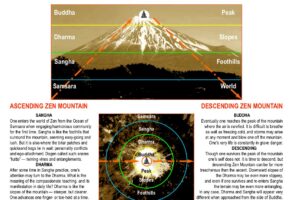
For Americans interested in pursuing a Zen practice, finding the right balance between the demands of household, work and family; and the necessary intensity of zazen practice may seem to be the most pressing and stressing dilemma in actualizing a Zen life.
We imagine that in simpler times, people had more time to spare, and could devote a greater share of their time to meditation and study. With all the touted time-saving devices of technology, we still seem to have little or no time to ourselves. The current droll expression, the hurrier I go, the behinder I get captures this syndrome. An ancient version of the same idea, from the Chinese Zen poem Hsinshinming: Faith Mind says it a bit differently, specifically relevant to Zen practice:
To live in the Great Way is neither easy nor difficult
But those with limited views are fearful and irresolute
The faster they hurry the slower they go
This is both a criticism of those who approach Zen practice with limited views as well as those who do not practice at all, and an admonition to practitioners to be fearless and resolute in pursuit of buddhadharma. This general mindset underlies Right Effort, and gives a clue to how we may achieve balance in our practice.
Usually when someone brings this issue up, it is an indication that they suspect that they are not practicing with sufficient intensity. They worry that it is not possible to find the time for zazen, both at home and away, without compromising obligations to family and career. For every project or task in which we invest the present moment, there are a dozen others that go wanting for our attention.
The source of this dilemma is the tendency of the discriminating mind to compartmentalize, dividing life into separate categories. The next step in the process is to set the various pieces in opposition to each other. Then we conceive of them as taking time to plan, engage, and complete. Thus we are forever caught in the bind of measured time, another compartmentalized conception. Taking this for reality, we see no way out.
Time and motion efficiency experts and life coaches apply various techniques to this problem, such as making it visible. One such approach recommends drawing up a pie chart, in which we give a portion of the whole to each of our regular activities, whether based on a 24-hour, weekly, monthly or annual cycle. Then we examine the activities to see if they are out of balance in some obvious way, looking to reduce one to make room for another, to arrive at a more desirable allocation of time to our goals and objectives. In other words, we use measurement of time to re-plan our measure of dedication to tasks.
If we closely examine this process, and pay attention to a singular subject which appear in conflict, it becomes apparent that the boundaries are not so clear. What we sort into categories are aspects of life that are more related than opposed. This is not a simplistic assertion that all is one, just an admission of the not-two nature of life.
If, for example, we imagine that time spent in zazen is time neglecting our family, we might remember that when we do not sit in zazen for some period, our relationship to our family begins to deteriorate. We may secretly, subliminally even, resent the fact that we have to give up something for the sake of spouse, children or parents—or worst case, in-laws—with their lack of appreciation of that sacrifice salting the wound.
We cannot balance our relationships to others when they are built on such underlying self-centered impulses to begin with. Our complaint that we do not have time to do zazen is a symptom that we do not understand either time or zazen. When we do zazen, we are using our time to its utmost efficiency and efficacy. When we leave the cushion, this mindset goes with us. We find that we waste less time in futile pursuits, or in resentment and acrimony between ourselves and those making demands on our time.
This is especially true at work. A majority of people report that they are happy with their work, those who have work in this time of economic contraction in the labor sector. Whether this happiness is genuine—or feigning of contentment in fear of losing a job, or confronting genuine underlying unhappiness—is anyone’s guess. It was probably not included in the questionnaire. But most of our discomfort at work is from relationships.
Compensation in terms of salary and benefits is always related to at least one other person, usually the identified “boss” or management in general, especially where unions are involved. It is difficult to apply the principles of compassionate engagement when the deck is stacked against us, with the other person holding all the trump cards. Often, we have no idea what they themselves make for being our boss, but they know everything— more than we would like—about us.
Our subordinates present another set of interpersonal issues, where we are on the hot seat in terms of supervising their performance and dealing with personalities that can be difficult. We are uncomfortably aware of the interconnectedness of our role in the enterprise with those in close proximity. We also have to be mindful of the viewpoint of others in the chain of command, to whom our boss reports. And over time, these roles and relationships are as impermanent as any other elements in the Buddhist universe. As the old adage has it, be nice to the people you meet on the way up the ladder; they are the same people you will meet on the way down.
Then there are client and supplier relationships outside the company; or students in the classroom; patients at the hospital. Patterns of relationships repeat, though the nature of the product or service varies. Sometimes disputes come out of left field, and we are blindsided with a conflict that begins to take up all of our time, including agonizing over it after work. At the end of the day—so ubiquitous a phrase that it is distasteful to repeat it—we begin to see home as a refuge from work. In some cases, work becomes a refuge from home. And the annual vacation becomes a refuge from both. Thus the annual calendar is sucked into the relentless maw of time consumption.
What if this is all just fantasy, simply the workings of our imagination? The monkey mind is endlessly capable of playing such games. What about a real vacation, a time-out from this merry-go-round?
Zazen has been referred to as a mini-vacation, a brief respite from the rat race. One of the great secrets of Zen is it really takes no time at all. In fact, Zen holds that we do not live in real time unless we enter into it through zazen.
When we think of the entire scope of a project, such as writing the great American novel, we shrink back in intimidation. The mountain seems insurmountable. But the mountain is climbed one step at a time, though we might prefer a helicopter. If we see a mountain as a series of molehills, it is not so daunting. The only question is, which molehill is in front of us at the moment?
If we think about all the other things that we do in a day that take a half-hour or so, are there none that we could easily forego, for the sake of sitting for a half-hour? If not, how about fifteen minutes? Ten? Five? As Matsuoka-roshi would often say, Sit five minutes: five-minute Buddha? Sit half-an-hour, Buddha for 30! But wouldn’t you rather be Buddha all day?
By this he did not mean sit zazen all day. The effects of zazen are both immediate and cumulative. They go with us, off the cushion. Our resistance to zazen is the molehill become mountain. I once worked for a Canadian company named DYLEX. It is an acronym, meaning Damn your lousy excuses! This is a compassionate message for us.








